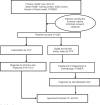Diagnostic agreement between a primary care physician and a teledermatologist for common dermatological conditions in North India
- PMID: 25657912
- PMCID: PMC4314882
- DOI: 10.4103/2229-5178.148927
Diagnostic agreement between a primary care physician and a teledermatologist for common dermatological conditions in North India
Abstract
Background: Primary care physicians (PCPs) encounter a large number of patients with dermatological diseases. However, delivering appropriate management is a challenge considering the inadequate dermatology training offered during the undergraduate medical curriculum. Teledermatology is the clinical evaluation of skin lesions by dermatologists and allows patients to be diagnosed and treated from a distant site. It is seen as a potential solution to the shortage of specialists and providing equitable service in remote areas.
Aim: The study was aimed at estimating the diagnostic agreement of common dermatological conditions between a PCP and a teledermatologist.
Materials and methods: Consecutive patients with dermatological ailments who attended a primary health care clinic were recruited into the study, examined by the PCP and offered a diagnosis. The clinical images and patients' history were collected and transferred to a dermatologist at a tertiary center who also made a diagnosis. Agreement between diagnosis made by the PCPs and the teledermatologist was measured using kappa (κ) statistics.
Results: Overall agreement between the diagnoses made by a PCP and the dermatologist was found to be 56%. Poor κ agreement (<0.4) was seen in the diagnosis of psoriasis and eczema.
Conclusion: Teledermatology can supplement specialist dermatology service in remote areas. There was poor agreement in the diagnosis of psoriasis, classifying various types of eczematous conditions and fungal infections. Scarce manpower in dermatology at the primary health care level compounded by the burden of skin ailments necessitates training of PCPs in common dermatological conditions.
Keywords: Dermatologist; diagnostic agreement; primary care physician.
Conflict of interest statement
References
-
- Gangadharan C, Joseph A, Sarojini A. Pattern of skin diseases in Kerala. Indian J Dermatol Venereol Leprol. 1976;42:49–51. - PubMed
-
- Dayal SG, Gupta GP. A cross section of skin diseases in Bundelkhand region, UP. Indian J Dermatol Venereol Leprol. 1977;43:258–61. - PubMed
-
- Kuruvilla M, Sridhar KS, Kumar P, Rao GS. Pattern of skin diseases in Bantwal Taluq, Dakshina Kannada. Indian J Dermatol Venereol Leprol. 2000;66:247–8. - PubMed
-
- Rao GS, Kumar SS, Sandhya Pattern of skin diseases in an Indian village. Indian J Med Sci. 2003;57:108–10. - PubMed
-
- Das KK. Pattern of dermatological diseases in Gauhati Medical College and Hospital Guwahati. Indian J Dermatol Venereol Leprol. 2003;69:16–8. - PubMed
LinkOut - more resources
Full Text Sources
Other Literature Sources


